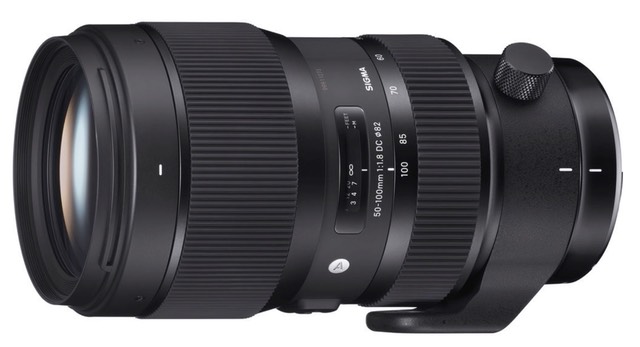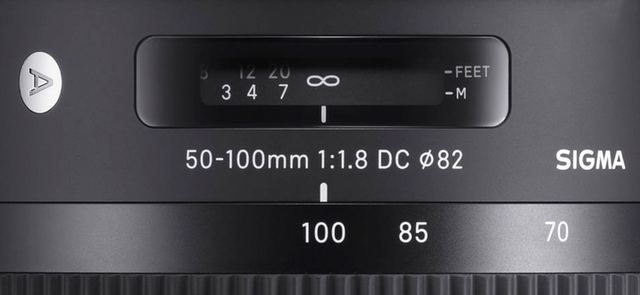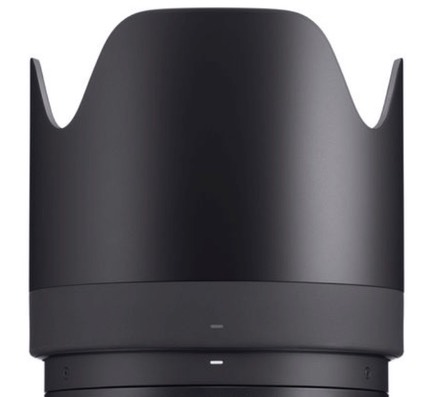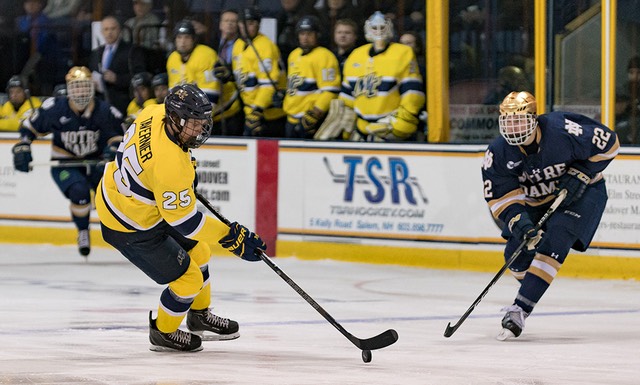
What is It?
The Sigma 50-100mm f/1.8 DC HSM Art lens is an interesting addition for the crop sensor camera choices. It's not exactly a 70-200mm equivalent, but it's also not the f/2.8 of those lenses, either.
Technically, a DX (crop sensor) user would want a 50-135mm f/2 lens to have a level of equivalency with FX (full frame) shooters. The Sigma delivers on much of that, being fast enough to keep the same narrow DOF at a given perspective, but it comes up shy on the telephoto end in terms of overall reach. Put in equivalency terms, what we have here is a 75-150mm f/2.8 lens, downsized appropriately for DX.
As you might expect, the 50-100mm f/1.8 is not a small lens. While it comes in a bit shorter than the traditional 70-200mm at less than 7" (171mm), it weighs 3.3 pounds (1490g).
Up front the f/1.8 aperture for 100mm forces an 82mm filter thread and a 3.7" (94mm) diameter. Overall in my bag, the Sigma needs just a slightly bigger slot than my Nikkor 300mm f/4.
The bayonet lens hood adds additional length to the lens in use (about 10" from mount to front of hood). On a crop-sensor body, this lens looks serious out front, and on the really light DX bodies such as the D3400 and D5600, makes the whole combination very front heavy.
What you'll immediately find missing is Sigma's OS (image stabilization). The only switch on the lens is the AF/MF focus switch. The lack of OS is often mentioned as a reason why people are overlooking this lens. Frankly, you want a fast telephoto for what? Sports. Wildlife. Events. In the first two, you're going to be pushing your shutter speed up, so OS isn't really an issue. It's only in the last category that any true concern might be met.
Still, f/1.8 on modern DSLR bodies? The f/1.8 nets you a lot of light getting to the sensor, and DX/APS-C sensors these days are pretty darned good at high ISO values. So you'd have to be in pretty dim light not get to get a usable 1/250 shutter speed, the minimum you should probably be hand-holding 100mm at on a crop sensor body.
Minimum aperture is f/16, and there are nine rounded aperture blades involved with the aperture. While some third party lenses lately are E-type, the Sigma is G-type (has mechanical aperture activation arm). Thus compatibility goes back to older Nikon DSLRs.
In terms of design, the lens is 21 elements in 15 groups, and we've got five special low dispersion elements scattered in there. Sigma makes a big deal about "thermally stable composite" materials used in the lens. Often with low dispersion elements, temperature can play a role in focus position and the internal light refraction. Sigma appears to be trying to mitigate that with this lens.
Close focus is just a bit over three feet (95cm). There's little "macro" about this lens, as the maximum magnification ratio is 1:6.7. The focus ring is the furthest to the front of the lens, the traditional position for zooms, and goes from minimum focus to infinity in just shy of a half turn. Focus markings are reasonably plentiful and at:
- Feet: 3.12, 3.5, 4, 5, 6, 7, 8, 12, 20 infinity
- Meters: 0.95, 1.25, 1.5 2, 3, 4, 7

The smaller zoom ring closer to the camera goes from 50 to 100mm in about a quarter of a turn, and is marked at 50, 60, 70, 85, and 100mm. The front lens element does not rotate, nor does it extend during focus or zoom.
The 50-100mm has a tripod collar. While it is a rotating collar that is click stopped at 90° intervals, it is not removable. Fortunately, it is also low profile, so when you spin it to the top of the lens there isn't much mass up there to get in the way, as there are with some designs. I will say that the collar is about as stable a collar I've seen on a lens recently.
The 50-100mm lens comes in Nikon F-mount, Canon EF mount, and Sigma SA mount. A t/2 version of the lens with markings and rings appropriate to video is available for the Canon EF, Sony FE, and the PL mount.
The lens is Sigma Dock compatible. Unusually, the year of manufacturing engraved on it (my sample says 016). The lens costs US$1099 and is designed and made in Japan.
Source of the review lens: purchased from dealer stock
How's it Handle?
It's big and heavy for the short focal length provided, but this lens is also as fast as many primes. The lens feels well balanced on my D500, less so on my D7200, and decidedly not on a D3400, where everything becomes front heavy.
Given the lack of OS on the lens, your left hand is going to be under the lens while shooting anyway, so the weight isn't a big deal. If the body/lens are reasonably balanced as they are on the D500, then you should find the handling just fine. But it hangs heavy off the neck!
Both rings on my sample are exceptionally smooth, though the focus ring has a bit of a faint rubbing sound as it is rotated large distances. In autofocus, the lens is pretty quiet, so much so that at times you're not sure it moved focus if you're going solely by sound.
If I have any complaints about the handling, it's the lens cap, and to a smaller degree, the lens hood. I don't know why, but getting the Sigma lens cap settled right on the lens, especially reaching through the lens hood when mounted, just seems fiddly to me. There's no clear and absolute engagement acknowledgement.
The hood bayonet is oddly marked. Instead of dots we have dashes. And while you can mount the hood at the point opposite of the markings, then you don't get an alignment mark showing that it's correct. Also, the arrows for "in" and "out" are ambiguous. "In" actually means turn ring this way to mount, while "out" means turn ring this way to remove. Why not just use "Mount" and "Remove"? And why isn't the "Remove" arrow shown where the lens is mounted:

Overall, I have no significant handling complaints. I do wish I could remove the tripod collar sometimes, but I can live with it the way it is.
How’s it Perform?
Focus: Unlike the Sigma 18-35mm f/1.8 I'm not finding any real issues with focus with this lens. It's fast, it's silent, it's accurate (though see my comment below about field shift). Like most Sigma HSM lenses, focus speed just simply isn't an issue, and unlike some Sigma HSM lenses, the 50-100mm f/1.8 is relatively quiet. Astonishingly, the lens is relatively close to parfocal—as opposed to the varifocal of most still camera zooms. That means that once focused, there's really no need to refocus at another focal length. There is a bit of focal length gain at 100mm as you focus closer, though.

Note that I did not find that the 50-100mm has the same off-center focus issues that the 18-35mm f/1.8 Sigma does.
Sharpness: There’s a slight increase of central sharpness stopping down to f/2, a bit more at f/2.8, which should be regarded as the sharpest aperture. But seriously, this is a sharp lens wide open and a wicked sharp lens stopped down just a bit. 100mm is the lens’ weakest focal length, 70mm the strongest, but at no point would I find it to be a slouch in the central region.

I'm shooting through plexiglass here (thankfully), so there's a slight softening due to that, plus there's ghosts on the surface I'm shooting through (look at the shorts of Leblanc). But if we follow the focus plane down we get to an area without much impact of the plexiglass. Considering this is a crop body at high ISO with a bit of noise reduction applied and that I'm more towards the edge of the frame than center, the level of detail retained is very, very good. Oh, we're at f/1.8 if you hadn't guessed.

At the edges of the frame, things are weaker, but still quite good for a fast zoom lens. f/4 is probably the best aperture for the corners, and the corners will always be weaker than the central area, but for a fast telephoto lens this is still very good performance.
Note that there’s a very slight field shift from f/1.8 to f/2.8 (towards infinity). Not enough to worry about, but something to be aware of if you’re really trying to nail acuity with this lens when focusing close, especially at 100mm: the depth of field will be shifting slightly backwards from where you think it is.
Astigmatism and coma are well corrected into the corners, unusual for a fast zoom lens. You’ll see some distortion of point-sized objects in the corner, but not nearly as much as you’d expect, and less than I see from most other telephoto lenses, prime or zoom.
Aberrations: Longitudinal chromatic aberration is clearly present at 50mm, less so at 100mm. Not a terrible performance here, but it’s something you need to be aware of if you’re using the lens wide open for the shallow depth of field.
Lateral chromatic aberration also follows this trend: more at 50mm, less at 100mm. I’d call it negligible and ignorable at 100mm, but you might want to do some correction at 50mm, even when stopped down.
Linear Distortion: Almost none at 50mm (a hard to measure slight barrel), increasing to visible pincushion at 100mm. While it’s visible, it’s less than 2%, so some people may not choose to correct it. Fortunately, it seems very regular in pattern, so correction is simple.
Vignetting: Surprisingly low for a very fast zoom lens, perhaps one stop in the corners at 50mm, as much as 1.3 stops in the corners at 100mm. Vignetting is also really only visible in the corners—the central area stays bright fairly far out from the middle. By f/2.8 vignetting is well under control at all focal lengths and mostly ignorable. There did seem to be a slight amount of miscentering of the vignette circle in my sample. Slight.
Image Circle: Since this is a DX lens (APS for you Canon users), you may wonder if you can use it on full frame (FX for Nikon). I’d say no. The image circle clearly doesn’t extend to the full frame corners. It’s possible, though, that you might be able to use something like the 5:4 or 1.2x crop and get usable results at 100mm stopped down to at least f/4. For everything else you’d get clipped corners.
Flare: You knew there had to be a weak point, right? Flare may be it. This lens can produce a very complex and cross frame set of colored patterns (mostly green/magenta) with a bright source in frame. Overall contrast remains decent, but there’s just a lot to try to fix visually. Indeed, most of the time I’d call it unfixable: you’re just going to see the flare pattern. Even with the light source out of frame, you may see some of that flare pattern. This is true at all focal lengths and apertures. Flare is very much the weak point of this lens, enough so that I would be careful shooting it into light sources.
Bokeh: I'm not floored by the bokeh on this lens, but it does seem to be relatively pleasant and benign. And at f/1.8 it is quite good.
Final Words
The big knocks on this lens are that it doesn't have image stabilization, and that it doesn't reach 135mm (which would make it more a 70-200mm equivalent for DX). Personally, I'm not bothered by either of those, as the types of shooting I'm doing with the lens are generally high shutter speed work trying to isolate out backgrounds, and I'm perfectly happy with 150mm equivalent at the long end.
Indeed, for wildlife work, I'm more worried about the short end. When the elephant approaches the vehicle and I've got a 70-200mm on the D500, well, at some point I'm just SOOL, as 105mm equivalent means I've only got a part of an elephant left in my frame. I mention elephants, because I find them very difficult to get good feature isolation shots of. Heck, I'd have loved it if the Sigma was 40-100mm, less so if it was 50-135mm.
The simple thing is this: if you want more isolation, just use a 70-200mm on the DX bodies. You'll miss the 70-105mm equivalent range, of course, but you'll get the isolation you want, perhaps from further away (change of perspective). But what I'm saying is this: for sports and wildlife for sure, and perhaps even theater, I'm finding the Sigma 50-100mm to be a very nice and appropriate telephoto zoom for the D500.
At US$1100 MSRP the lens is not only appropriately sized for DX, but is appropriately priced, as well. The build quality seems quite good. While not specifically weather sealed, it seems like it will hold up in mild conditions. About all I can say negatively is that I'm not a fan of the front lens cap and hood, both of which I find a little fiddly.
It used to be that there was a lens that went from 75-150mm (f/3.5) that was very famous and in a lot of photographers' bags. Well, I'm here to say that Sigma took that a step further, and gave us a modern equivalent that any DX user ought to be contemplating.
Recommended (2016 to present)